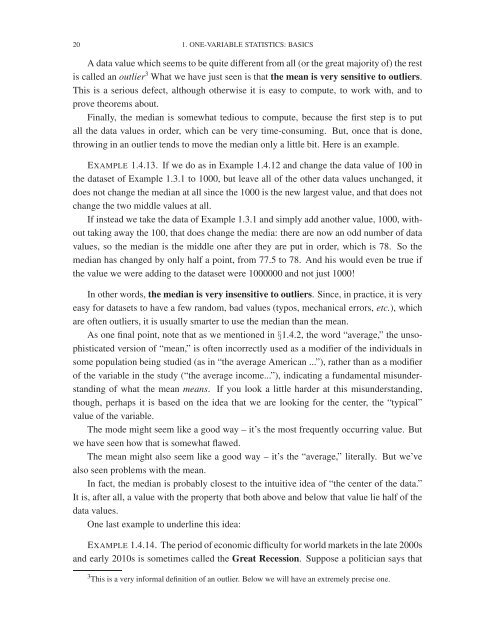Lies, Damned Lies, or Statistics- How to Tell the Truth with Statistics, 2017a
Lies, Damned Lies, or Statistics- How to Tell the Truth with Statistics, 2017a
Lies, Damned Lies, or Statistics- How to Tell the Truth with Statistics, 2017a
You also want an ePaper? Increase the reach of your titles
YUMPU automatically turns print PDFs into web optimized ePapers that Google loves.
20 1. ONE-VARIABLE STATISTICS: BASICS<br />
A data value which seems <strong>to</strong> be quite different from all (<strong>or</strong> <strong>the</strong> great maj<strong>or</strong>ity of) <strong>the</strong> rest<br />
is called an outlier 3 What we have just seen is that <strong>the</strong> mean is very sensitive <strong>to</strong> outliers.<br />
This is a serious defect, although o<strong>the</strong>rwise it is easy <strong>to</strong> compute, <strong>to</strong> w<strong>or</strong>k <strong>with</strong>, and <strong>to</strong><br />
prove <strong>the</strong><strong>or</strong>ems about.<br />
Finally, <strong>the</strong> median is somewhat tedious <strong>to</strong> compute, because <strong>the</strong> first step is <strong>to</strong> put<br />
all <strong>the</strong> data values in <strong>or</strong>der, which can be very time-consuming. But, once that is done,<br />
throwing in an outlier tends <strong>to</strong> move <strong>the</strong> median only a little bit. Here is an example.<br />
EXAMPLE 1.4.13. If we do as in Example 1.4.12 and change <strong>the</strong> data value of 100 in<br />
<strong>the</strong> dataset of Example 1.3.1 <strong>to</strong> 1000, but leave all of <strong>the</strong> o<strong>the</strong>r data values unchanged, it<br />
does not change <strong>the</strong> median at all since <strong>the</strong> 1000 is <strong>the</strong> new largest value, and that does not<br />
change <strong>the</strong> two middle values at all.<br />
If instead we take <strong>the</strong> data of Example 1.3.1 and simply add ano<strong>the</strong>r value, 1000, <strong>with</strong>out<br />
taking away <strong>the</strong> 100, that does change <strong>the</strong> media: <strong>the</strong>re are now an odd number of data<br />
values, so <strong>the</strong> median is <strong>the</strong> middle one after <strong>the</strong>y are put in <strong>or</strong>der, which is 78. So <strong>the</strong><br />
median has changed by only half a point, from 77.5 <strong>to</strong> 78. And his would even be true if<br />
<strong>the</strong> value we were adding <strong>to</strong> <strong>the</strong> dataset were 1000000 and not just 1000!<br />
In o<strong>the</strong>r w<strong>or</strong>ds, <strong>the</strong> median is very insensitive <strong>to</strong> outliers. Since, in practice, it is very<br />
easy f<strong>or</strong> datasets <strong>to</strong> have a few random, bad values (typos, mechanical err<strong>or</strong>s, etc.), which<br />
are often outliers, it is usually smarter <strong>to</strong> use <strong>the</strong> median than <strong>the</strong> mean.<br />
As one final point, note that as we mentioned in §1.4.2, <strong>the</strong> w<strong>or</strong>d “average,” <strong>the</strong> unsophisticated<br />
version of “mean,” is often inc<strong>or</strong>rectly used as a modifier of <strong>the</strong> individuals in<br />
some population being studied (as in “<strong>the</strong> average American ...”), ra<strong>the</strong>r than as a modifier<br />
of <strong>the</strong> variable in <strong>the</strong> study (“<strong>the</strong> average income...”), indicating a fundamental misunderstanding<br />
of what <strong>the</strong> mean means. If you look a little harder at this misunderstanding,<br />
though, perhaps it is based on <strong>the</strong> idea that we are looking f<strong>or</strong> <strong>the</strong> center, <strong>the</strong> “typical”<br />
value of <strong>the</strong> variable.<br />
The mode might seem like a good way – it’s <strong>the</strong> most frequently occurring value. But<br />
we have seen how that is somewhat flawed.<br />
The mean might also seem like a good way – it’s <strong>the</strong> “average,” literally. But we’ve<br />
also seen problems <strong>with</strong> <strong>the</strong> mean.<br />
In fact, <strong>the</strong> median is probably closest <strong>to</strong> <strong>the</strong> intuitive idea of “<strong>the</strong> center of <strong>the</strong> data.”<br />
It is, after all, a value <strong>with</strong> <strong>the</strong> property that both above and below that value lie half of <strong>the</strong><br />
data values.<br />
One last example <strong>to</strong> underline this idea:<br />
EXAMPLE 1.4.14. The period of economic difficulty f<strong>or</strong> w<strong>or</strong>ld markets in <strong>the</strong> late 2000s<br />
and early 2010s is sometimes called <strong>the</strong> Great Recession. Suppose a politician says that<br />
3 This is a very inf<strong>or</strong>mal definition of an outlier. Below we will have an extremely precise one.

















